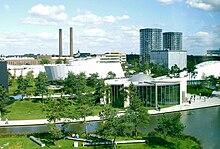Brandland
A Brandland is a world of experience created around a brand and its products in the form of a local center, as an exhibition , museum , leisure or theme park . Brandland is generally perceived as a leisure activity, but it is part of a company's brand communication . The purpose is to make a brand world an interactive experience and to relate it to positive experiences in order to increase the brand value.
definition
The term Brandland is from the English and freely translated means brand world, but in German the term brand world has a different meaning. Brand originally stands for identifying mark made by a hot iron . In the literature there is no generally uniform definition or exact delimitation of the term, but only agreement on the following constitutive characteristics of a fire country:
- durability
- Locality
- Experience
- Emotional staging
function
Brandlands are set up and operated by companies as a marketing tool . You belong in the field of corporate communication and take on a number of tasks to strengthen brand loyalty, which ideally do not burden the marketing budget. In a brand country, brands and products of a company are presented in a positive world of experience and can usually also be experienced interactively. The aim is to cognitively bind a brand to positive emotions. In addition, a brand country regularly generates media attention in extended topics such as lifestyle or tourism and can tap into TV coverage in addition to print media. Most of the larger companies today use Brandlands to win new customers, to retain existing customers and to improve the overall image in order to increase the brand value .
history
The forerunners of the Brandlands are the showrooms, which have been known since the middle of the 19th century. As early as 1860, the sewing machine manufacturer Singer announced its products in demonstration rooms in various major American cities and the chocolate manufacturer Hershey opened the first theme park in 1906 . Larger fire lands did not emerge until a few decades later, such as the Disney Park , which was built in Anaheim , California, from 1954 . The multi-storey showroom of the Sony Building, built in Tokyo in 1966, is considered one of the oldest fire lands in the world. For the first time, products in Plexiglas were exhibited from the inside. This was followed by Legoland , which opened in Billund , Denmark in 1968 , where you could experience the possibilities of Lego bricks in an amusement park. The Autostadt, which opened in Wolfsburg on May 31, 2000, is currently the largest brand area in Germany.
The most famous Brandlands
- Disneyworld of the Walt Disney Company in 6 locations worldwide
- Universal Studios Hollywood of Universal Studios in Universal City, California
- Autostadt of Volkswagen AG in Wolfsburg
- BMW Museum of BMW AG in Munich
- Playmobil FunPark of the Brandstätter Group at 4 locations worldwide
- German Football Museum of the German Football Association (DFB) in Dortmund
- Ferrari World of Ferrari NV at two locations worldwide
- Porsche Museum of Porsche AG in Stuttgart
- Museum nest of Nestle in Vevey
- RWE Meteorit Adventure Park from RWE AG in Essen
- Swarovski Crystal Worlds from D. Swarovski AG in Wattens
- Mercedes-Benz Museum of Daimler AG in Stuttgart
- Ravensburger Spieleland of Ravensburger AG in Ravensburg
- Colorful chocolate world from Alfred Ritter GmbH & Co. KG in Berlin
- Krombacher adventure world of the Krombacher brewery Bernhard Schadeberg GmbH & Co. KG in Kreuztal
- Miele Museum of Miele & Cie. KG in Gütersloh
- Brown collection of Braun GmbH in Kronberg im Taunus
- Faber Castle of Faber-Castell AG in Stein near Nuremberg
- Warner Bros. Movie World by WarnerMedia, LLC in Oxenford (Queensland)
literature
- Nadine Enke: Brand Lands as a corporate communication tool - success factors, possible uses, benefits and effects . Diplomica, 2003, ISBN 3-8324-6734-3 .
Individual evidence
- ↑ a b c Manfred Kirchgeorg, Christiane Springer, Christian Brühe: Live Communication Management: A strategic guideline for conception, implementation and success control . Gabler Verlag, 2009, ISBN 978-3-8349-1025-7 , pp. 124 ff . ( limited preview in Google Book search).
- ↑ a b Christian Mikunda: Feeling marketing: welcome to the third place . 3. Edition. Redline Verlag, 2007, ISBN 978-3-636-01424-5 , pp. 53 ff . ( limited preview in Google Book search).
- ↑ Christiane Springer: Multisensual Brand Management: A behavioral analysis with special focus on brand lands in the automotive industry . Gabler Verlag, 2008, ISBN 978-3-8349-0900-8 , pp. 15 ( limited preview in Google Book search).
- ^ Franz-Rudolf Esch: Brandland. In: Gabler Wirtschaftslexikon. Springer, accessed September 6, 2018 .
- ^ Karsten Kilian: Brandland. In: Brand Lexicon. Marketing, accessed on September 6, 2018 .
